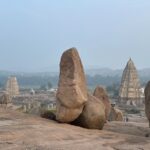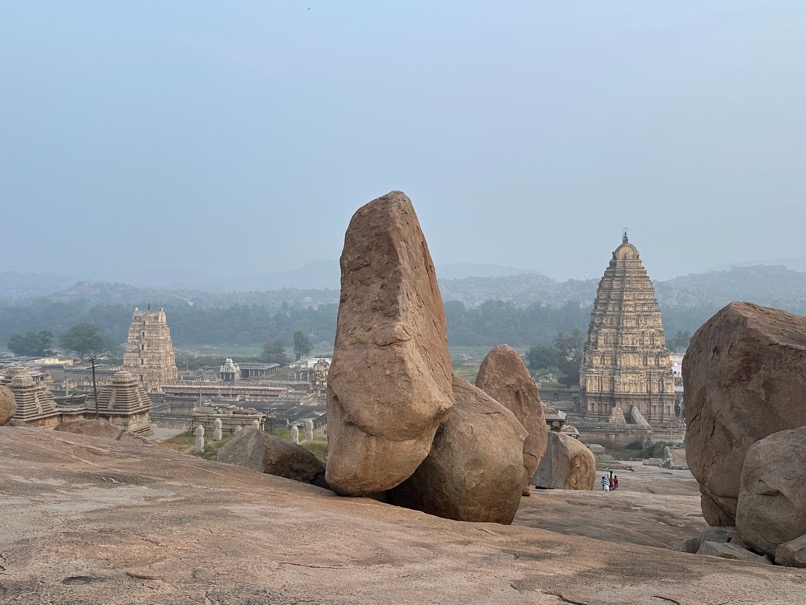
The ancient Indian scriptures have always sought to unravel the mysteries of existence, freedom, and the very essence of being. Among these profound works, the Śivasūtra stands as a masterpiece of Trika Tantric philosophy, delving deep into the enigma of consciousness. Rooted in the mystical experiences of Vasugupta and consistent with the Vedic tradition, it offers answers to questions that remain elusive even to modern science.

Vijayanagar, Shiva temple, 27.11.24
"Who are we? Why are we here? Are we truly free?" These perennial questions have perplexed humanity across millennia. While science perceives humans as complex machines, reducing consciousness to a byproduct of neural processes, it fails to address the spiritual and subjective dimensions of awareness. Consciousness, as the Śivasūtra reveals, is not an object to be studied but the perceiving subject itself—a luminous light that illuminates both inner and outer realities.
The Śivasūtra posits that consciousness is the primal force binding the fragmented perceptions of the world into a coherent whole. This unifying principle is Śiva, the Universal Consciousness, while its dynamic, creative aspect is Śakti. Together, they form the ultimate reality, transcending ordinary language and conceptualization.
The Ṛgveda poetically captures the relationship between Universal and Individual Consciousness in the metaphor of two birds sitting on a tree—one eating the fruit (the individual) and the other merely observing (the universal). Yet, the deeper truth is their oneness: the individual is but a reflection of the universal.
This duality resonates through the Śivasūtra, where Śiva (the universal self) reflects upon itself as Śakti, creating a world of forms and phenomena. This interplay is characterized by free will (svātantrya), bliss (ānanda), and creative illumination (pratibhā), representing the dynamic dance of consciousness.
Why isn’t everyone a genius? The Śivasūtra explains that the brilliance of consciousness is often obscured by mental conditioning, habits, and societal imprints (saṃskāras). Creativity arises when these veils are lifted, allowing spontaneous insights to emerge. This light of intuition (pratibhā), though beyond the mind, is translated into action within time and space, creating transformative experiences.
The journey to this state of creative brilliance requires the seeker to traverse beyond waking, dreaming, and deep sleep to the turīya, the "fourth state" of pure awareness. It is here, in this transcendent realm, that the individual merges with the universal, unveiling the boundless potential of consciousness.
The Paradox of Freedom and Bondage
Śiva, as Paśupati (Lord of Beings), binds sensory perceptions into coherent experiences. Yet, this very binding is also the source of freedom. The Śivasūtra illustrates this paradox: humans, like domesticated animals (paśu), are bound by their perceptions, yet the same consciousness that binds also liberates.
Through yogic practices, one can dismantle these bindings, transcending misconceptions (vikalpas) and impurities (malas). The process is both painful and liberating, a sacrifice of the false self for the true self.
The Śivasūtra unfolds in three transformative movements:
Each movement addresses the core of existence, urging the seeker to strip away the layers of the social self and uncover the essence of being. This process of inner transformation is the ultimate sacrifice, leading to liberation.
Central to the Śivasūtra is the role of mātṛkā, the womb of elementary sounds that underpins all language. These phonemes, when charged with insight, bridge the gap between the universal and the individual. Meditation on these sounds transforms perception, revealing the hidden pathways to self-realization.
Language, as both a tool and a limitation of the mind, becomes the key to transcendence. By detaching from the associations of ordinary language, the practitioner opens themselves to the light of knowledge, unveiling the universal consciousness that lies beyond.
The Śivasūtra invites us to partake in Śiva’s cosmic dance—a dance that represents the eternal interplay of creation, preservation, and dissolution. It challenges us to question the nature of our senses, to explore the limits of perception, and to embrace the mystery of existence.
Meditation on Śiva reveals that consciousness is not bound by the physical, temporal, or spatial dimensions. It is the very fabric of reality, pulsating with infinite potential. As we journey through the movements of the Śivasūtra, we are reminded of our own luminous essence, poised to transcend and transform.
In the words of the Ṛgveda:
"He became the original form of every form; It is his form that is everywhere to be seen."
Picture: Lilleoru, before Shiva havan 27.01.25
